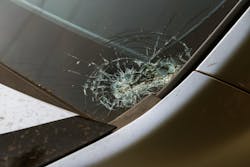Content brought to you by Auto Body Repair Network. To subscribe, click here.
What you'll learn:
- What the AGRSS is
- Why the AGRSS is critical to proper ADAS operation
The Auto Glass Safety Council (AGSC) has recently announced its update of the Automotive Glass Replacement Safety Standard (AGRSS). Automotive tools manufacturer Topdon has pledged conformity to the new updated standard.
An evolving industry
Since 1999, AGSC has maintained the AGRSS as the gold standard for safety-oriented professionals in the auto glass replacement industry. While each automobile manufacturer has its own internal specifications for auto glass installation on the assembly line, the real-world environment that auto glass replacement professionals operate under necessitated a more specialized approach. AGRSS bridges that gap.
Over the years, advances in safety technology meant addressing not just physical glass installation, but also the entire ecosystem of safety architecture surrounding auto glass functionality. With the growing adoption of windshield area mounted camera systems as part of ADAS, it has become increasingly important to take a wider view of the glass replacement process beyond just swapping out parts.
Facing new challenges
With the updated 2022 AGRSS, new sections have been added with information addressing ADAS-related topics such as calibration, dynamic recalibration/calibration, and static recalibration/calibration. The previous 2018 standard mentioned ADAS calibration/recalibration as necessary for ADAS equipped vehicles, but did not address the framework around the process. The new 2022 standard now includes details such as calibration/recalibration equipment requirements, vehicle manufacturer compatibility, as well as software and data coverage. It also includes language strictly prohibiting any and all alterations or modifications of calibration/recalibration equipment without manufacturer permission. All calibration/recalibration equipment must also be maintained as instructed by the equipment manufacturer. While some of these statements may seem common sense, it is important that they be codified so that the auto glass industry can operate from a common point of view.
Putting safety first
With these important details in mind, Topdon has announced its adoption and support of the new ANSI/AGSC/AGRSS 005-2022 standard through its suite of ADAS tools and technology. Each Topdon calibration/recalibration system is manufactured to a documented internal quality control process. Each internal quality control process utilizes equipment that is applicable and compatible with both the software and hardware associated with performing the appropriate calibration/recalibration. Each Topdon calibration/recalibration system (including software and hardware), when operated as designed and as directed, meets and/or exceeds the associated vehicle manufacturer’s documented calibration/recalibration requirements.
About the Author

Brian Medford
With an automotive writing career spanning over two decades, Brian has a passion for sharing the automotive lifestyle. An avid DIYer, he can usually be found working on one of his many project cars. His current collection includes a 1969 Olds Delta 88 convertible and a slant-6-powered 1975 Plymouth Duster.
